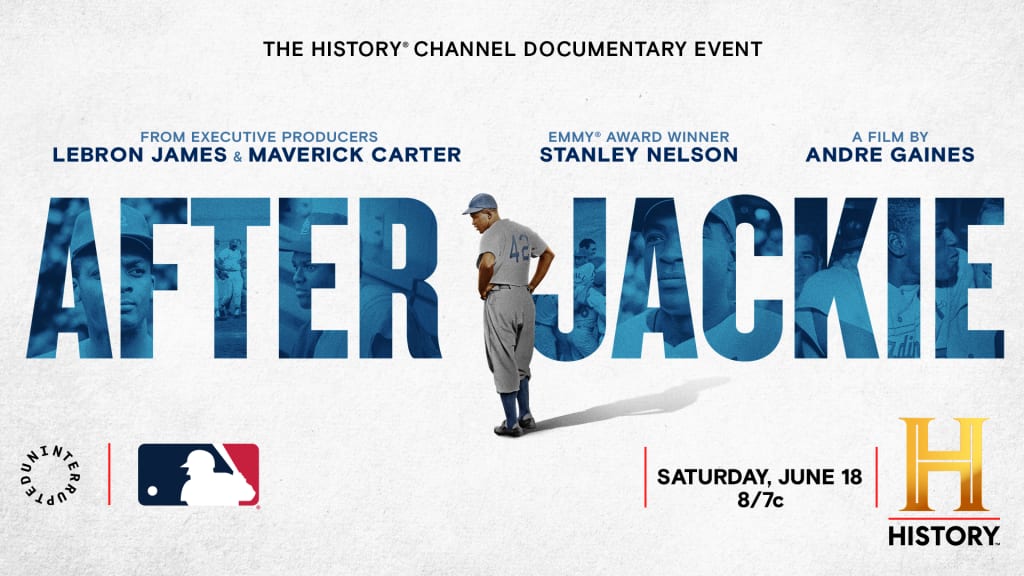On April 15, 1947, Jackie Robinson broke Major League Baseball’s color barrier when he debuted with the Brooklyn Dodgers, a groundbreaking moment that forever changed baseball.
But there was more work to do, and as baseball continued to integrate, the responsibility to continue pushing for progress fell to the Black players who entered the big leagues after Robinson. That part of history, which includes many stories that have gone untold up until now, is the focus of a new documentary, titled “After Jackie.”
On Saturday, June 18, at 8 p.m. ET, the History Channel will air the two-hour documentary, which delves into several stories about how Black players – specifically, Hall of Famer Bob Gibson, Bill White and Curt Flood – fought racial discrimination in an effort to push the sport into a new standard of acceptance and inclusivity. The show was executive produced by UNITERRUPTED, the sports media platform founded by NBA star LeBron James.
The film features rare interviews with White and Gibson, as well as former and current players, that explore more than a century of baseball history.
“Living outside of baseball was really difficult,” Gibson said in an interview prior to his passing in 2020. “We had more problems with trying to find places to live than trying to play the game.”
Flood, Gibson and White were a big part of a Cardinals nucleus that carried them through the 1960s and helped earn World Series titles in 1964 and '67. These players challenged how the game was played, and how Black players were treated off the field.
A struggling Cardinals club tested just how groundbreaking Black players could be by forming its core three with Gibson, a right-handed pitcher who was in the Cardinals farm system; White, a first baseman who returned to the New York Giants after military duty without a roster spot and was traded to St. Louis; and Flood, who was traded by the Cincinnati Reds to the Cardinals prior to the 1958 season.
“I think for the first time a player said, ‘Trade me’, and that was me,” White said. “That upset our general manager, and he sent me to the Cardinals, which was the best thing to ever happen to me.”
In their first two seasons, the three players lived separate and entirely different lives from their teammates. That changed in 1961 when Ralph Wimbish, a Florida-based physician and Civil Rights advocate who helped set up alternate lodging for Black players during Spring Training, pushed hotel owners and Major League Baseball officials to integrate its player housing. Wimbish, who also often housed Black players at his residence, stopped assisting with housing all together, forcing teams to find their own resolutions.

That act gained national attention. In response to the discrimination Black players were receiving in St. Petersburg, the Yankees moved their Spring Training site to Fort Lauderdale. That put the attention squarely on the Cardinals, and White, who later became the first Black president of the National League in ‘89, met with owner August Anheuser Busch Jr. to discuss the Spring Training housing situation. Busch bought a hotel for the players, both Black and white, enabling them to interact on even grounds.
“We became all about the St. Louis Cardinal baseball,” Tim McCarver, Gibson’s catcher, said. “We had a harmonious situation, but Bill White was responsible for that.”
This drastic change proved successful to help complete the integration of baseball, as it forced the St. Louis team to bond. This created a cohesive unit that had yet to be seen, 15 years after Robinson broke the color barrier.
After St. Louis traded for Lou Brock in 1964, the club had all the necessary pieces to make it to the World Series that year. That’s around the same time that Gibson began to emerge as the first Black ace of a ballclub.
Gibson's career ultimately created a pathway for future Black players. His dominance on the mound – he posted a 1.12 ERA and recorded 13 shutouts in 1968 – proved that Black players weren’t just entertainment in a white man’s game. They were major contributors to America's pastime.
Many players fought for change, but few garnered more public attention than Flood, who, as his career declined, filed a lawsuit against MLB and its restrictive "reserve clause" in 1972. Although he lost the case, the suit led to the eventual creation of free agency for any player after six years of Major League service time.
“What we are often led to believe is that [Robinson breaking baseball’s color barrier] was the end of the fight,” said Damion L. Thomas, Sports Curator at The Smithsonian National Museum of African American History and Culture. “The truth is that the struggles continued, in particular, three players: Bill White, Bob Gibson and Curt Flood had to fight battles that Jackie [Robinson] didn’t fight and that changed the game.”
Thirteen years after the four legends won their first World Series, Major League Baseball retired Robinson's No. 42 forever on April 15, 1997, the 50th anniversary of breaking the color barrier. A decade later, future Hall of Famer Ken Griffey Jr. asked the baseball Commissioner Bud Selig if he could wear the number in memory of the legend, and Selig took it a step further to have all players wear it.
In 2022, MLB celebrated the 75th anniversary of Robinson’s debut with the Dodgers. “After Jackie” is a celebration, too – of what happened next.
“Thank God for them that they were able to go through it and make my life easier,” Griffey Jr. said of Robinson, Flood, White and Gibson. “Those are the four guys that should never die in Major League Baseball.”
